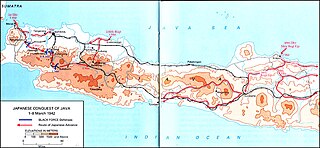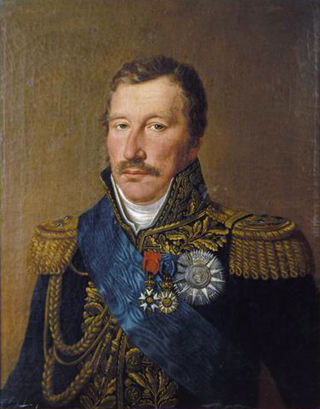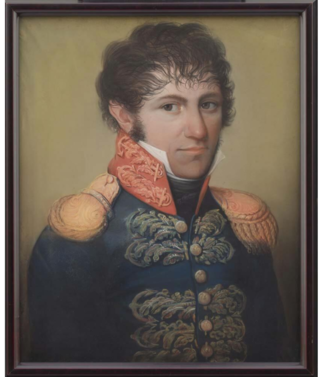
The Royal Netherlands East Indies Army was the military force maintained by the Kingdom of the Netherlands in its colony of the Dutch East Indies, in areas that are now part of Indonesia. The KNIL's air arm was the Royal Netherlands East Indies Army Air Force. Elements of the Royal Netherlands Navy and Government Navy were also stationed in the Netherlands East Indies.

David Hendrik, Baron Chassé was a Dutch soldier who fought both for and against Napoleon. He commanded the Third Netherlands Division that intervened at a crucial moment in the Battle of Waterloo. In 1830 he bombarded the city of Antwerp as commander of Antwerp Citadel during the Belgian Revolution.

Caspar Georg Carl Reinwardt was a Prussian-born Dutch botanist. He is considered to be the founding father of Bogor Botanical Garden in Indonesia.

Godert Alexander Gerard Philip, Baron van der Capellen was a Dutch statesman. He held several important posts under the Kingdom of Holland and the Sovereign Principality of the United Netherlands, before he was appointed as one of the Commissioners-General of the Dutch East Indies. Later he was appointed Governor-General of that colony.

The Battle of Java was a battle of the Pacific theatre of World War II. It occurred on the island of Java from 28 February – 12 March 1942. It involved forces from the Empire of Japan, which invaded on 28 February 1942, and Allied personnel. Allied commanders signed a formal surrender at Japanese headquarters at Bandung on 12 March.

Dirk van Hogendorp was a Dutch military officer, politician, colonial administrator and diplomat. In 1812 he was governor of Vilnius, in 1813 he was appointed as the governor of Hamburg. He was an early critic of the Dutch colonial system as implemented under the VOC. His ideas about reforms in the Dutch East Indies were to a large extent realized by the Commissioners-General of the Dutch East Indies, through the behind the scenes influence of his friend Herman Warner Muntinghe, first as adviser of Stamford Raffles, and later as adviser of the Commissioners-General.

The 1740 Batavia massacre was a massacre and pogrom of ethnic Chinese residents of the port city of Batavia, Dutch East Indies, in the Dutch East Indies. It was carried out by European soldiers of the Dutch East India Company and allied members of other Batavian ethnic groups. The violence in the city lasted from 9 October 1740, until 22 October, with minor skirmishes outside the walls continuing late into November that year. Historians have estimated that at least 10,000 ethnic Chinese were massacred; just 600 to 3,000 are believed to have survived.

Carl Heinrich Wilhelm Anthing was a German officer, in Dutch service under several successive regimes, starting with the Dutch Republic, and followed by the Batavian Republic, the Kingdom of Holland, and the First French Empire, to end up in the United Kingdom of the Netherlands, where he led the Indies Brigade, both at Waterloo, and finally to the Dutch East Indies, where it would be the core of the future Royal Netherlands East Indies Army.

The French and British interregnum in the Dutch East Indies of the Dutch East Indies took place between 1806 and 1816. The French ruled between 1806 and 1811, while the British took over for 1811 to 1816 and transferred its control back to the Dutch in 1816.
Van Bylandt's brigade is the nickname, used in military historiography for the 1st brigade of the 2nd Netherlands division of the Mobile Army of the United Kingdom of the Netherlands, a Dutch and Belgian infantry brigade led by Major General Willem Frederik Graaf van Bylandt which fought in the Waterloo Campaign (1815).
The Commissioners-General of the Dutch East Indies was a commission instituted by the Dutch king William I of the Netherlands in 1815 to implement the provisions of the Anglo-Dutch Treaty of 1814 and take over the government of the Dutch Indies from the British lieutenant-governor of Java, John Fendall. The commission consisted of the following three members: Godert van der Capellen, Arnold Adriaan Buyskes, and Cornelis Theodorus Elout. One of their tasks was to implement a new Regeringsreglement for the colony that they carried in draft form with them. But instead, they promulgated a much-amended version of that draft at the end of their mission in 1818. It embodied a transition from the "trade colonialism" of the VOC to an embryonic form of "imperial power colonialism," which would come to full fruition during the 19th century. The "constitution" they wrote would remain in force for the Dutch East Indies in the main, though with important amendments, like the institution of the Volksraad, until the end of Dutch colonial rule.

MS Van Heutsz was a Dutch diesel-powered passenger and cargo vessel of the Koninklijke Paketvaart-Maatschappij (KPM) line operating from Batavia in the Dutch East Indies. The ship, as was sister ship Cremer, was designed for the longer routes of the East Indies inter-island trade extending to Singapore and Hong Kong. The ships had limited cabin accommodation for passengers but large deck passenger capacity. Much of the passenger trade was with Chinese moving between China, Singapore and the East Indies.

Quirijn Maurits Rudolph Ver Huell was a Dutch naval officer, writer, painter, watercolorist and entomologist. He played an important role in the suppression of the insurrection of Pattimura on Saparua in 1817. He was the captain of the Dutch ship of the line Zr. Ms. Admiraal Evertsen when that ship foundered near Diego Garcia in 1819 with an important cargo of irreplaceable botanical specimens on board, that had been gathered by the founder of the Bogor Botanical Gardens, Caspar Georg Carl Reinwardt. He was something of a polymath, who earned a reputation as a naturalist and in particular as an illustrator of works of botany, zoology and entomology. He was the last director of the renowned naval shipyard of Rotterdam. He received several high decorations, among which that of Knight 3rd class of the Military Order of William. He played an important role in the social and cultural life of Rotterdam. He was the father of Alexander Willem Maurits Carel Ver Huell.

Cornelis Theodorus Elout was a Dutch statesman. As Commissioner of the Dutch East Indies he instituted the landrente tax system in the Dutch East Indies in 1816, and in 1819 promulgated the new Regeringsreglement for that colony together with his colleagues Godert van der Capellen and Arnold Adriaan Buyskes, while also reforming the coinage. After his return to the Netherlands he served as Minister of Finance, Industry, Colonies, and the Navy. He was instrumental in founding the Nederlandsche Handelsmaatschappij. He opposed the introduction of the Cultuurstelsel in the East Indies, but was overruled, and resigned in protest.

Arnold Adriaan Buyskess was a Dutch naval officer, who also served as a Commissioner-General of the Dutch East Indies from 1816 to 1819. Before that he had been Daendels lt.-Governor-General on Java from 1808 to 1809. He successfully led the punitive expedition against the insurgents in the Moluccas in 1817.
Herman Warner Muntinghe was a Dutch chief justice of the Supreme Court of the Dutch East Indies and a colonial official who had great behind the scenes influence in the successive colonial governments of the Indies under governor-general Herman Daendels, lt-governor-general Sir Stamford Raffles, and the Commissioners-General of the Dutch East Indies. He was appointed a member of the first High Government of the Dutch East Indies in 1819.
Jacob Andries van Braam was a Dutch opperkoopman of the VOC and member of the High Government of the Dutch East Indies.
Reinier d'Ozy was a Dutch colonial administrator who rose to be a member of the High Government of the Dutch East Indies.
Alexandre Charles Joseph Ghislain Count d'Aubremé was a Southern Netherlands general in the service consecutively of the First French Republic, the Batavian Republic, the Kingdom of Holland, the First French Empire, the Sovereign Principality of the United Netherlands, and the United Kingdom of the Netherlands. He commanded the 2nd brigade of the 3rd Netherlands division at the Battle of Waterloo. He served as Minister of War under king William I of the Netherlands.

Hendrik Jan van de Graaff was a Dutch jurist who became a Raad van Indië in 1820, and was an ally of governor-general Godert van der Capellen, until he was recalled in 1826.















